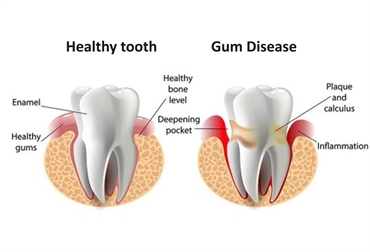Exploring the Causes and Solutions of Gum Disease
November 21, 2023

Gum disease, or periodontal disease, is a prevalent oral health condition affecting a significant portion of the population. Understanding its causes, symptoms, and effective treatments is essential for maintaining oral health and preventing serious complications.
This article explores the causes and solutions of gum disease. Read on to learn more.
Understanding Gum Disease
Gum disease is primarily caused by plaque buildup, a sticky film of bacteria that forms on the teeth. If not removed through regular brushing and flossing, plaque can harden into tartar, leading to inflammation of the gums, known as gingivitis.
If left untreated, gingivitis can progress to periodontitis, a more severe form of gum disease that can damage the gums and bones supporting the teeth. Such progression highlights the importance of maintaining oral hygiene to prevent the onset and advancement of gum disease.
Risk Factors Contributing to Gum Disease
Several factors contribute to the development of gum disease. Some of them include:
• Poor oral hygiene: This is a primary contributor, as it allows plaque and tartar buildup.
• Smoking: This can exacerbate the accumulation of plaque and tartar and hinder gum tissue healing.
• Genetics: This plays a role by predisposing some individuals to gum disease regardless of their oral care practices.
• Certain medications: This can affect saliva production or gum health, increasing vulnerability.
• Hormonal fluctuations: These fluctuations, especially in women, can make gums more susceptible to disease.
• Chronic conditions: Serious medical conditions like diabetes can impair the body’s ability to combat infections, elevating the risk of gum complications.
Recognizing and managing these factors is crucial in preventing and reducing the likelihood of developing gum disease.
Symptoms and Diagnosis
Gum disease manifests through various symptoms, with redness, swelling, and bleeding of the gums being common initial signs. Bad breath, often persistent and not alleviated by standard oral hygiene, can indicate bacterial accumulation associated with gum disease. Receding gums, exposing more of the tooth or its root, and losing teeth further indicate advancing disease, signaling weakening support structures.
Diagnostically, dentists conduct comprehensive oral examinations and focus on the depth of the pockets between gums and teeth, a critical measure of gum health. X-rays may also be used to assess bone loss, an advanced consequence of untreated gum disease.
Preventative Measures to Consider
Prevention is critical in managing gum disease. This includes:
• Regular Oral Hygiene: Adhering to a diligent routine of brushing at least twice daily and flossing is fundamental. This practice removes plaque, the primary cause of gum disease, and prevents buildup.
• Routine Dental Visits: Regular check-ups and professional cleanings with a dentist are essential. These visits help identify and address early signs of gum disease and remove tartar, which brushing alone can’t eliminate.
• Quitting Smoking: Smoking is a significant risk factor for gum disease. Giving up smoking aids in improving gum health and overall oral hygiene.
• Managing Health Conditions: Chronic conditions like diabetes can exacerbate gum disease. Proper management of such health issues is crucial in reducing the risk and severity of gum disease.
By taking preventive measures for gum disease, you can help protect your oral health and overall well-being.
Gum Disease Treatment Options
Once gum disease develops, treatment options vary depending on the severity of the condition. For early stages of gum disease, the following solutions are highly advised:
• Scaling and Root Planing: Dentists may recommend this as part of your gum disease treatment regimen. It involves deep cleaning below the gum line to remove plaque and tartar and smoothing the tooth roots to help gums reattach.
• Antimicrobial Mouth Rinses: Dentists may prescribe these rinses for treating gum disease. These can help reduce bacteria in the mouth, thereby controlling infection and inflammation.
• Frequent Dental Cleanings: Regular cleanings at shorter intervals are advised to keep the disease under control and prevent further progression.
These treatments focus on controlling the infection and preventing further damage to the gums and teeth.
Advanced Treatment Options
In more advanced cases, surgical treatments for gum disease may be necessary. These can include:
• Flap surgery: This is a procedure where the gums are lifted back to remove tartar from deep pockets and then sutured back in place, which is a common approach. This allows for deeper cleaning and better healing.
• Bone and tissue grafts: These are utilized to regenerate and replace the tissues and bone lost to periodontitis.
• Guided tissue regeneration: This is where a small piece of biocompatible fabric is inserted between the bone and gum tissue, encouraging the body’s natural regenerative processes to rebuild and restore the damaged areas.
These surgical options aim to restore gum and bone health, preventing further deterioration.
The Role of Lifestyle Changes
In addition to medical treatments, lifestyle changes play a significant role in managing gum disease. This includes:
• Maintaining a balanced diet rich in nutrients: This can support overall oral health, aiding in gum tissue repair and strengthening teeth.
• Reducing stress: This is also vital, as stress can weaken the immune system, making it harder to fight off infections, including those in the gums.
• Avoiding detrimental habits: These habits, mainly smoking and excessive alcohol consumption, are harmful to your oral health. Smoking impairs blood flow to the gums, hindering healing, while heavy alcohol use can contribute to oral irritation and dehydration, exacerbating gum problems.
These lifestyle adjustments can complement medical treatments to provide a holistic approach to gum disease management.
Final Words
Gum disease is a common yet preventable and treatable condition. By keeping the information mentioned above in mind, you’ll understand its causes, risk factors, and symptoms, which are essential for early intervention and effective management. Remember, you can maintain healthy gums and oral health in the long run with proper care and treatment.

